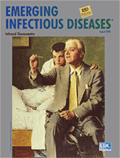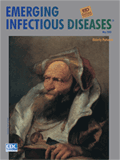Podcasts
New Podcasts
Homelessness and Bartonella quintana Infections
Thelazia callipaeda Eyeworms in American Black Bear, Pennsylvania, USA, 2023
Infectious Diseases and Clinical Xenotransplantation
Past Podcasts
Volume 7-2001 and Volume 5-1999 are links to podcasts recorded in 2015 about articles that appeared in EID during those years. Volume 12-2006 is a link to a podcast recorded in 2018.
Volume 14—2008
Zoonoses
In this podcast, Dr. King discusses zoonoses and how foxes, raccoons, and bats play an important role in the ecology of infectious diseases, such as rabies.
Download Transcript
View full-text article: Influenza Infection in Wild Raccoons
Zoonoses
In this podcast, Dr. King discusses zoonoses and how foxes, raccoons, and bats play an important role in the ecology of infectious diseases, such as rabies.
Download Transcript
View full-text article: Highly Pathogenic Avian Influenza Virus (H5N1) Infection in Red Foxes Fed Infected Bird Carcasses
Zoonoses
In this podcast, Dr. King discusses zoonoses and how foxes, raccoons, and bats play an important role in the ecology of infectious diseases, such as rabies.
Download Transcript
View full-text article: Detection and Phylogenetic Analysis of Group 1 Coronaviruses in South American Bats
Rabies Elimination in Dogs in the United States
Rabies has been eliminated from dogs in the United States through efforts to promote annual vaccination, but it's still a problem in wildlife in the U.S. and in wild and domesticated animals abroad. In this podcast, CDC's Dr. Charles Rupprecht discusses a study which provides proof of the elimination of rabies in dogs and what this means for the average American.
Download Transcript
View full-text article: Enzootic Rabies Elimination from Dogs and Reemergence in Wild Terrestrial Carnivores, United States
Multidrug-Resistant Tuberculosis
In this podcast, Dr. Oeltmann discusses multidrug-resistant tuberculosis. An outbreak occurred in Thailand, which led to 45 cases in the U.S. This serious illness can take up to 2 years to treat. MDR TB is a real threat and a serious condition.
Download Transcript
View full-text article: Multidrug-Resistant Tuberculosis Outbreak among US-bound Hmong Refugees, Thailand, 2005
Cryptosporidium Infections Among Children in Peru
Cryptosporidium is a waterborne bacteria that can cause severe diarrhea and vomiting. In this podcast, Dr. Vita Cama, CDC microbiologist, discusses an article in the October 2008 issue of Emerging Infectious Diseases. The paper examines Cryptosporidium infections among children in Peru, including the number of infections, symptoms experienced, and what species of Crypto were responsible.
Download Transcript
View full-text article: Cryptosporidium Species and Subtypes and Clinical Manifestations in Children, Peru
Prophylaxis after Exposure to Coxiella burnetii
In this podcast, Dr. David Swerdlow discusses prophylaxis after exposure to Coxiella burnetii. It is important to know who should be treated and how they should be treated after an intentional release with possible bioterrorism agents, including Coxiella burnetii.
Download Transcript
View full-text article: Prophylaxis after Exposure to Coxiella burnetii
Reporting of Outbreaks of Foodborne Illness under the International Health Regulations
During the past 20 years, the global food trade has increased and, with it, the potential for the spread of foodborne illnesses caused by imported foods. The World Health Organization in 2007 implemented new International Health Regulations which help guide reporting of foodborne outbreaks. In this podcast, CDC's Dr. Scott McNabb discusses a study in the September 2008 issue of the journal Emerging Infectious Diseases which analyzed foodborne outbreaks in Australia in the early part of this decade and assessed how many would have been reported under the current health regulations.
Download Transcript
View full-text article: Obligations to Report Outbreaks of Foodborne Disease under the International Health Regulations (2005)
Human Noroviruses and Sporadic Gastroenteritis
In this podcast, Dan Rutz speaks with Dr. Manish Patel, a medical officer with the Division of Viral Diseases at CDC, about an article in August 2008 issue of Emerging Infectious Diseases reporting on nororviruses. Dr. Patel reviewed 235 studies and identified 31 original studies about noroviruses. Norovirus is the leading cause of epidemic gastroenteritis.
Download Transcript
View full-text article: Systematic Literature Review of Role of Noroviruses in Sporadic Gastroenteritis
Community-Associated MRSA in Uruguay
Methicillin-resistant Staphylococcus aureus is an antibiotic-resistant bacterium that is typically associated with infections in healthcare settings. In the past couple of decades, MRSA has emerged in the community, most often causing skin infections in healthy people who haven't recently been hospitalized. After an increase in community cases in Uruguay in 2004, health officials investigated to learn more about what was happening and found some interesting trends. In this podcast, CDC's Dr. Stephen Benoit discusses what they learned, the results of which are published in the August 2008 issue of CDC's journal, Emerging Infectious Diseases.
Download Transcript
View full-text article: Community Strains of Methicillin-Resistant Staphylococcus aureus as Potential Cause of Healthcare-associated Infections, Uruguay, 2002–2004
Clostridium difficile in Humans and Food Animals
Clostridium difficile is an antibiotic-resistant bacterium that causes diarrhea and sometimes serious intestinal illnesses. In recent years, C. difficile infections have been increasing in number and severity, including among some people outside healthcare settings. In this podcast, CDC's Dr. Michael Jhung discusses his recent study that looked at a new, increasingly prevalent strain of C. difficile in people and compared it to a strain historically found in animals to see whether the two might be linked. The study is published in the July 2008 issue of Emerging Infectious Diseases.
Download Transcript
View full-text article: Toxinotype V Clostridium difficile in Humans and Food Animals
Cryptosporidium and Giardia intestinalis in Swimming Pools, Atlanta, Georgia
In this podcast, Dan Rutz speaks with Dr. Joan Shields, a guest researcher with the Healthy Swimming Program at CDC, about an article in June 2008 issue of Emerging Infectious Diseases reporting on the results of a test of swimming pools in the greater Atlanta, Georgia area. Dr. Shields tested 160 pools in metro Atlanta last year for Cryptosporidium and Giardia. These germs cause most recreational water associated outbreaks.
Download Transcript
View full-text article: Prevalence of Cryptosporidium spp. and Giardia intestinalis in Swimming Pools, Atlanta, Georgia
In Memoriam: Joshua Lederberg
In this podcast, Dr. Peter Drotman, Editor-In-Chief of the Emerging Infectious Disease journal speaks with Dr. Jim Hughes, about an article in the June 2008 issue of Emerging Infectious Diseases. They discuss Dr. Joshua Lederberg, globally recognized scientist, educator, national and Presidential scientific advisor, and Nobel Laureate who recently died at the age of 82. Dr Lederberg's early work in bacterial genetics virtually established the discipline of molecular biology, earning him a Nobel Prize in Physiology or Medicine in 1958 when he was only 33 years old.
Download Transcript
View full-text article: In Memoriam: Joshua Lederberg (1925–2008)
Slowing the Next Pandemic: Survey of Community Mitigation Strategies
During the next influenza pandemic, it will take time to develop a vaccine and there may be limited medication to treat or prevent illness. To slow the spread of disease, CDC and other public health officials will likely ask Americans to decrease contact with others through altering work schedules, school dismissals and other measures. Researchers recently surveyed the public to see whether people could follow those recommendations and what kind of impact they might have.
Download Transcript
View full-text article: Public Response to Community Mitigation Measures for Pandemic Influenza
The Mystery of Increased Hospitalizations of Elderly Patients
Pneumonia is a common illness that affects millions of people in the United States every year. In some people, particularly the elderly and those who are ill from pre-existing conditions, bacterial pneumonia may follow influenza or even a common cold. Dr. Martin Meltzer, discusses two articles in the May 2008 issue of Emerging Infectious Diseases journal about increased pneumonia-related hospitalizations of elderly patients in England.
Download Transcript
View full-text article: Increasing Hospital Admissions for Pneumonia, England
Determining the Quality of Oseltamivir (Tamiflu)
The possibility of an avian flu pandemic has given Tamiflu attention. Because of fear of a pandemic, this drug has been in high demand. Unfortunately, this demand has prompted production of counterfeit Tamiflu. CDC's Dr. Mike Green discusses a test that is simple and affordable and can test the quality of products purported to be oseltamivir (Tamiflu).
Download Transcript
View full-text article: Determination of Oseltamivir Quality by Colorimetric and Liquid Chromatographic Methods
Disparities in Arctic Health
Life at the top of the globe is drastically different. Harsh climate devoid of sunlight part of the year, pockets of extreme poverty, and lack of physical infrastructure interfere with healthcare and public health services. Learn about the challenges of people in the Arctic and how research and the International Polar Year address them.
Download Transcript
View full-text article: The International Polar Year, 2007–2008, An Opportunity to Focus on Infectious Diseases in Arctic Regions
The conclusions, findings, and opinions expressed by authors contributing to this journal do not necessarily reflect the official position of the U.S. Department of Health and Human Services, the Public Health Service, the Centers for Disease Control and Prevention, or the authors' affiliated institutions. Use of trade names is for identification only and does not imply endorsement by any of the groups named above.














